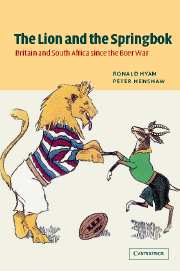Book contents
- Frontmatter
- Contents
- List of illustrations
- List of tables
- Preface
- Acknowledgements
- List of abbreviations
- 1 The uneasy special relationship: dynamics and divergencies
- 2 Breakdown: into war, 1895–1899
- 3 Post-war: the myth of magnanimity, 1905–1907
- 4 African interests and the South Africa Act, 1908–1910
- 5 ‘Greater South Africa’: the struggle for the High Commission Territories, 1910–1961
- 6 The economic dimension: South Africa and the sterling area, 1931–1961
- 7 Britain, the United Nations, and the ‘South African disputes’, 1946–1961
- 8 The political consequences of Seretse Khama and Ruth, 1948–1952
- 9 Containing Afrikanerdom: the geopolitical origins of the Central African Federation, 1948–1953
- 10 Strategy and the transfer of Simon's Town, 1948–1957
- 11 The parting of the ways: the departure of South Africa from the Commonwealth, 1951–1961
- 12 Enfeebled lion? How South Africans viewed Britain, 1945–1961
- 13 Springbok reviled: some British reactions to apartheid, 1948–1994
- Epilogue The relationship restored: the return of the new South Africa to the Commonwealth, 1994
- Select bibliography
- Index
6 - The economic dimension: South Africa and the sterling area, 1931–1961
Published online by Cambridge University Press: 03 December 2009
- Frontmatter
- Contents
- List of illustrations
- List of tables
- Preface
- Acknowledgements
- List of abbreviations
- 1 The uneasy special relationship: dynamics and divergencies
- 2 Breakdown: into war, 1895–1899
- 3 Post-war: the myth of magnanimity, 1905–1907
- 4 African interests and the South Africa Act, 1908–1910
- 5 ‘Greater South Africa’: the struggle for the High Commission Territories, 1910–1961
- 6 The economic dimension: South Africa and the sterling area, 1931–1961
- 7 Britain, the United Nations, and the ‘South African disputes’, 1946–1961
- 8 The political consequences of Seretse Khama and Ruth, 1948–1952
- 9 Containing Afrikanerdom: the geopolitical origins of the Central African Federation, 1948–1953
- 10 Strategy and the transfer of Simon's Town, 1948–1957
- 11 The parting of the ways: the departure of South Africa from the Commonwealth, 1951–1961
- 12 Enfeebled lion? How South Africans viewed Britain, 1945–1961
- 13 Springbok reviled: some British reactions to apartheid, 1948–1994
- Epilogue The relationship restored: the return of the new South Africa to the Commonwealth, 1994
- Select bibliography
- Index
Summary
South Africa's long and loyal membership of the sterling area is one of the most remarkable features of that country's relations with Britain in the twentieth century (tables 6.1–6.3; figs. 6.1–6.4). Membership of the area signified a commitment to sustain a world-wide monetary and trading system that was the economic counterpart to and underpinning of the British empire and Commonwealth. Yet for the Afrikaner nationalists who dominated the South African government between 1924 and 1933, and again after 1948, there was no higher ambition than to free their country from subordination to Britain. What, then, induced successive South African governments to tie the value of the country's currency to sterling, conduct the bulk of its international business in sterling, and adopt measures which protected Anglo-South African trade from outside competition when, as the world's leading gold producer, South Africa could dig out of the ground what was for much of the century the most prized medium of international exchange?
The sterling area first took recognisable shape in 1931 when Britain's abandonment of the gold standard forced other countries, including autonomous members of the Commonwealth such as South Africa, to choose between aligning their currencies with sterling or fixing them on some other basis. The overseas dominions, with their long-standing political and economic ties with Britain, may have seemed natural candidates for membership of the sterling area, since in many ways the area merely preserved an existing system of international economic relations.
- Type
- Chapter
- Information
- The Lion and the SpringbokBritain and South Africa since the Boer War, pp. 118 - 145Publisher: Cambridge University PressPrint publication year: 2003



